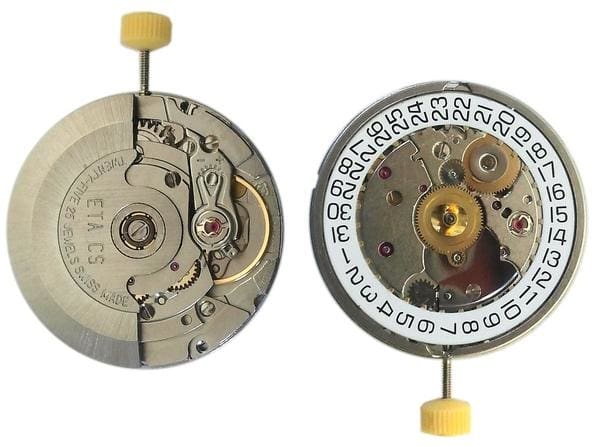August 17 2017
As most of you surely know, the majority of watch makers don’t have their own in-house movements. They usually purchase their movements from ETA, Valjoux and other firms. This became exceptionally common after the advent and popularity of quartz driven watches. Everyone wanted a quartz watch for their unparalleled precision, reliability and dirt cheap pricing. This forced the surviving watch makers to start buying movements rather than developing their own. There are of course exceptions such as the new Breitling B01 movement.
So I would like to give you a comparison review of these two extremely common automatic movements. These movements have been used in countless watches for many years. They are excellent movements and provide accurate and reliable mechanics for your coveted time pieces. We see the Genuine ETA 2824-2 Swiss Watch Movement in many watch makers brands like Omega, Breitling, & Tag Heuer. While the Japanese Miyota 8215 Watch Movement is common in lower priced watches from Invicta and Citizen.
These two automatic movements are very similar, but have some significant differences which create different functionality and applications. The Genuine ETA 2824-2 Swiss Watch Movement would cost a watch maker less than $200 dollars. Imagine that, your watch that you spent thousands of dollars on has a $200 movem!. What about the Japanese Miyota 8215 Watch Movement? Well, it can be purchased for under $100 dollars. So the price difference is the first thing we noticed. What do you get for the 100% price hike between the ETA and the Miyota?
What about the Japanese Miyota 8215 Watch Movement? Well, it can be purchased for under $100 dollars. So the price difference is the first thing we noticed. What do you get for the 100% price hike between the ETA and the Miyota?

The ETA 2824-2 is a 25 jewel movement at 28,800 beats per hour, 8 beats per second or 4Hz. The more affordable Miyota comes in at 21 jewels and will beat at 21,600 BPH, 6 betas per second or 3Hz. What does this mean? It means the ETA movement is smoother and more accurate, because it beats faster. However both watches are above average. Traditionally, mechanical watches were always 2.5Hz (18,000 BPH.)
There are also aesthetic issues between the ETA and the Miyota. The ETA offers gold plating and high polish mechanics. Unless you have an open heart watch cover, you probably won’t notice the difference. So this would only affect those that like to inspect their movements; watch makers, repair shops and those who buy open heart watches.
Both watches utilize synthetic rubies in their movements. The ETA as we said earlier has 25 jewels while the Miyota has a 21 jewel movement. These jewels are used to reduce friction and wear on moving parts, they aren’t bling. Cheaper watches often have as few as 15 jewels. So once again both watch movements are well above the 17 jewel average.
Both movements are automatics, using a winding rotor to power the main spring as you move around during the day. So what happens when you don’t wear your watch for a bit? Automatic movements have a power reserve built in. What’s the difference between the two then? The ETA comes in at a very respectable 40 hours of reserve, but the Miyota trumps it in this category with 45 hours! That being said, the ETA does utilize ball bearings for the rotor, which means it’s more efficient at winding the watch, requiring less wrist time per day to keep it going.
Let’s talk precision! The ETA movement comes in with factory direct second hand drive. It will not stop for moments at a time due to wrist movements unlike the indirect drive that Miyota offers in the 8215. This is again an aesthetic issue, since second hand drive won’t affect the accuracy of the watch. Both watch movements also offer excellent shock resistance. The ETA uses Incabloc, which is a method that allows jewels to float when the watch is bumped. The Miyota has a proprietary shock resistance called the Parashock.
Overall the ETA 2824-2 is the winner in this comparison, but both movements are very reliable!
